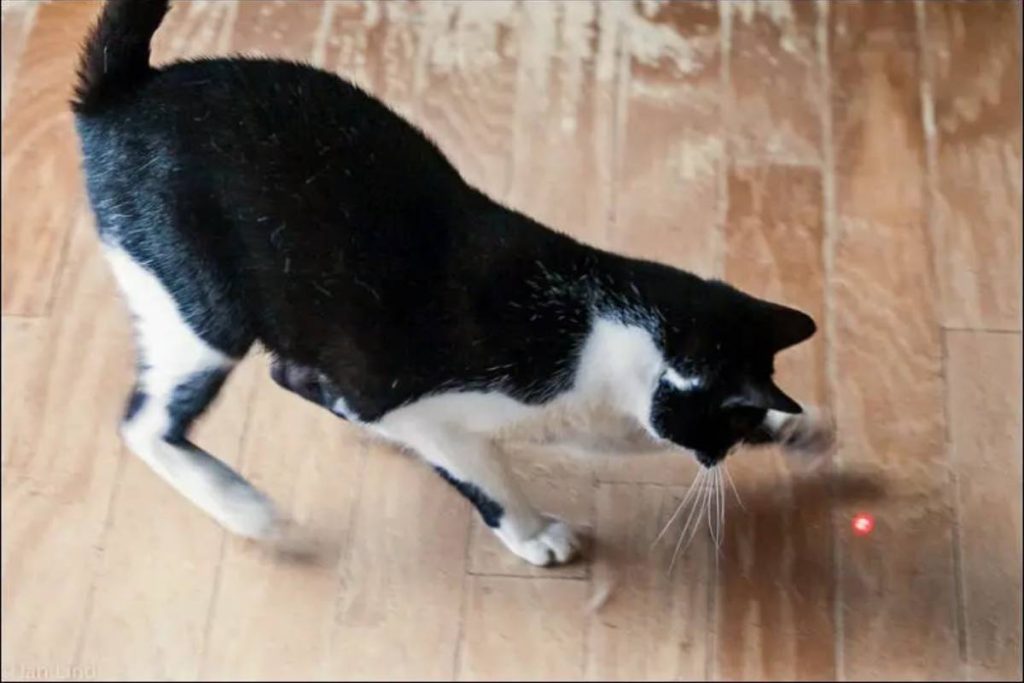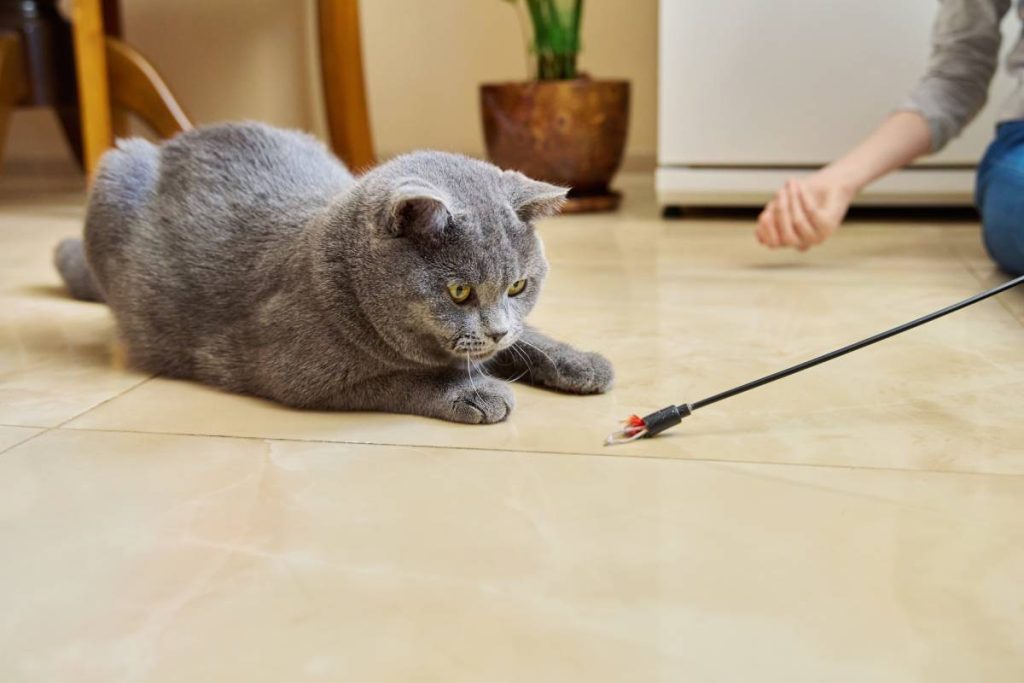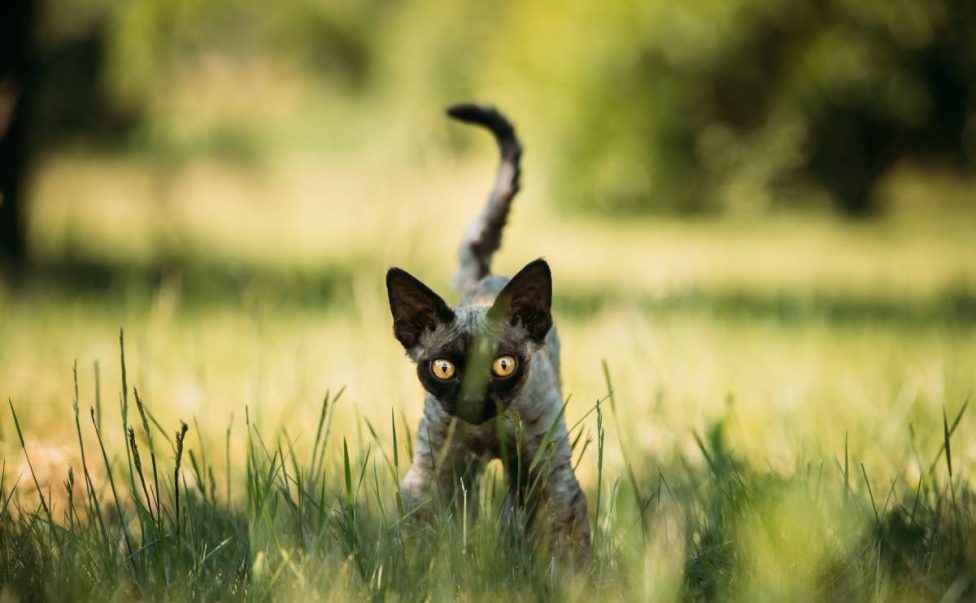Why cats chase laser dots? Is it a good toy for your cat?
Every cat owner knows the ongoing battle between their cat and the elusive red dot of a laser pointer. Despite its tiny size and lack of scent, that little dot can keep cats entertained endlessly, even though they can never quite catch it.
But are laser pointers really the best toy for our cats? Let’s explore why cats chase lasers and whether it might be better to switch to a different type of toy.
The Appeal of Laser Pointers
Laser pointers hold a unique allure for cats, captivating them with their mimicry of fast-moving prey. Despite the domesticated lifestyle of most pet cats, their instinctual hunting behaviours remain intact, making the elusive red dot of a laser pointer irresistible.
Cats are natural predators, and their evolutionary history has primed them for the chase. Even though modern cats may not need to hunt for their food, the sight of a moving target triggers their innate instincts. When the laser dot dances around the room, it simulates the movements of small prey trying to escape, activating a range of hunting behaviours.
For a cat, the pursuit of the laser dot is not merely a game—it’s a serious hunt. The sight of the moving light stimulates their senses, prompting them to stalk, pounce, and attempt to “catch” their elusive prey. Despite the fact that the laser is just a harmless light, the cat’s brain interprets it as a tangible target to pursue.
What makes the laser pointer so appealing to cats is its ability to engage their natural instincts. Unlike other toys that may lose their novelty over time, the laser provides endless entertainment as it mimics the movements of potential prey. For cats, this kind of stimulation is essential for their physical and mental well-being, especially for indoor cats who may not have access to outdoor hunting opportunities.
The fact that the laser pointer offers a safe and convenient outlet for a cat’s hunting instincts is a major reason why it has become a popular toy among cat owners. It allows cats to engage in their natural behaviours without the risk of harming themselves or other creatures.

How Cats Perceive Lasers
The key to understanding a cat’s attraction to lasers lies in the structure of their eyes, particularly the retina. The retina contains two types of photoreceptor cells: rods and cones. Rods are highly sensitive to light and motion, making them essential for detecting movement in low-light conditions, while cones are responsible for colour vision.
Cats have a higher concentration of rod cells compared to cone cells, which gives them superior night vision and motion detection capabilities. This means that cats are adept at detecting even the slightest movements, making them highly effective hunters.
When a laser pointer is activated, the bright dot of light instantly grabs a cat’s attention. Due to their abundance of rod cells, cats can easily detect the rapid movement of the laser dot, even in their peripheral vision. This triggers their natural hunting instincts, as they perceive the dot as potential prey attempting to flee.
The allure of the laser lies in its ability to mimic the movements of prey animals. Cats instinctively track and stalk the moving dot, exhibiting behaviours similar to those used when hunting live prey in the wild. Despite the fact that the laser is merely a light projection and not tangible prey, cats are drawn to it because it triggers their primal instincts.
Moreover, the unpredictability of the laser’s movements adds an extra layer of excitement for cats. Unlike static toys, which may lose their appeal over time, the erratic movements of the laser keep cats engaged and stimulated for extended periods.
The combination of their heightened sensitivity to motion and the irresistibly tantalizing nature of the laser pointer makes it an irresistible toy for cats. It provides them with both mental and physical stimulation, allowing them to indulge their natural instincts in a safe and controlled environment.
Furthermore, the presence of other interactive toys such as a robot vacuum can provide additional enrichment for cats. While laser pointers engage their hunting instincts, robot vacuums stimulate their curiosity and provide physical activity as cats follow or observe the vacuum’s movements. Incorporating a variety of toys and activities into a cat’s environment can ensure a well-rounded and engaging experience for them.
The Controversy Around Cats and Lasers
The debate over whether using laser pointers to entertain cats is a good idea may come as a surprise to some, but it’s a discussion that has been ongoing for quite some time.
Critics argue that using lasers can be problematic because it essentially teases cats. When a cat chases the red dot, it’s not just playing; it’s following its natural hunting instincts. The issue arises because the laser dot is an impossible target—no matter how skilled the cat is, it can never catch or “kill” it. This disrupts the cat’s natural hunting cycle, leading to potential frustration and behavioural issues.
Some cats may figure out that the laser dot is unattainable and lose interest over time. However, others may become increasingly frustrated and may exhibit destructive or aggressive behaviours as a result. If you notice a pattern of negative behavior after playing with the laser, it’s important to recognize this and consider discontinuing its use.

To address these concerns and make laser play more satisfying for your cat, there are several strategies you can try. One approach is to end the laser play session with a reward, such as a treat or a physical toy. This provides your cat with a sense of satisfaction and accomplishment, even if they haven’t caught the elusive laser dot. By associating the end of the game with a positive outcome, you can help mitigate any potential frustration your cat may feel.
Additionally, it’s important to provide your cat with plenty of other toys and enrichment activities to prevent over-reliance on the laser pointer. This ensures that your cat has a variety of outlets for play and stimulation, reducing the risk of boredom and frustration.
Ultimately, the decision to use a laser pointer as a toy for your cat depends on your individual pet’s preferences and behaviours. While some cats may enjoy the thrill of the chase without any negative consequences, others may become stressed or frustrated. By being attentive to your cat’s reactions and adjusting your playtime accordingly, you can ensure that laser play remains a fun and enriching experience for both you and your feline companion.
Laser Pointer Safety Tips
If your cat genuinely enjoys chasing a laser and doesn’t get stuck in a cycle of endless hunting without reward, there’s usually nothing to worry about. It’s a great way for your cat to exercise physically and mentally, and it allows them to indulge their natural instincts—a rare opportunity for indoor cats.
However, it’s important to follow some safety guidelines to ensure your cat’s well-being during play. Here are two key tips:
- Avoid shining the light directly into your cat’s eyes. Even toy lasers emit a bright light that can potentially harm your cat’s vision if shone directly at them (or yourself!). This could lead to eye injuries or vision problems.
- Offer your cat a variety of toys. Relying solely on the laser for play may lead to frustration. Ensure your cat has access to a range of toys for hunting and playing, such as catnip toys and wands, to keep them entertained and satisfied.


